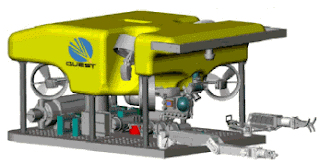http://phys.org/news/2012-11-underwater-robots-smart-explore-treacherous.html
http://www.learnaboutrobots.com/undersea.htm
http://www.ypte.org.uk/news.php?id=189
Under
water robotics are pretty cool. I do not know if it’s something I would do
personally as a job but it is pretty interesting. They are helping the environment
by fixing reefs such as the coral reef in Scotland. I like marine biology and
oceanography that’s why chose to talk about this. I’m glad that they are able
to be environmentally friendly. They aren’t dangerous for the world or for
people and they can go lower than divers can in the ocean, they are like
underwater divers. Under water robots are called AUVs sometimes. There are
submarine AUVs too. The only thing that could possibly be wrong with the underwater
robotics is that one of the rechargeable battery companies that most of the big
AUVs use can be very dangerous if you don’t handle it very carefully, other
than that they are extremely good for the environment. Also since they can go
deeper than divers can they can get better pictures that human divers can’t. They
will be able to take pictures of sharks and whales and other aquatic species
that might harm humans if they took the picture.



